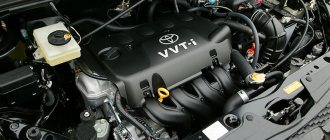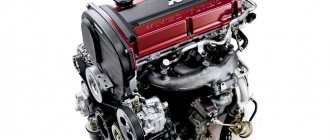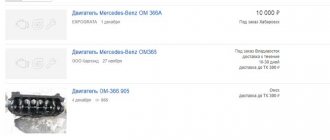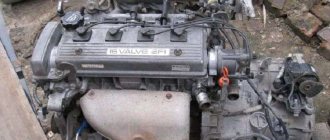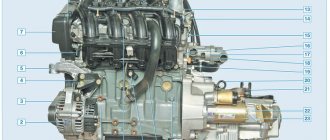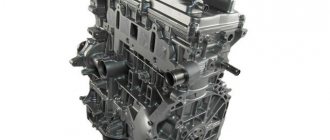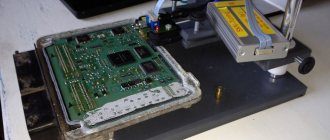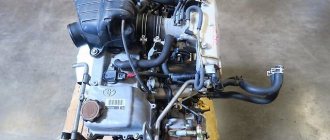Toyota 1AZ-FE and 2AZ-FE engines and their main components
- ____________________________________________________________________________
- Toyota 1AZ-FE and 2AZ-FE engines of Toyota Camry, Toyota Rav 4, Lexus RX have two modifications:
- — Toyota 1AZ-FE engine: four-cylinder, in-line, with a displacement of 2.0 liters, with a 16-valve cylinder head.
— Toyota 2AZ-FE engine: four-cylinder, in-line, with a displacement of 2.4 liters, with a 16-valve cylinder head.
Technical data and engines of Toyota 1AZ-FE / 2AZ-FE cars Toyota Camry, Toyota Rav 4, Lexus RX
Toyota 1AZ-FE / 2AZ-FE engine Number and arrangement of cylinders - 4-cylinder, in-line Valve mechanism - 16-valve, double overhead shaft (DOHC), chain driven (with VVT-i) Combustion chamber - Tent type Manifolds - With transverse gas exchange Fuel System - Electronic Fuel Injection (EFI) Ignition System - DIS (Divide Coil Ignition System) Displacement cm3 (cu.in.) - 1998 (121.9) / 2362 (144.2) Bore and piston stroke, mm - 86.0 x 86.0 / 88.5 x 96.0 Compression ratio 9.8: 1 Maximum power [according to EEC standard] - 112 kW at 6000 min-1 / 125 kW at 6000 min-1 Maximum torque [EEC standard] - 194 Nm at 4000 rpm 224 Nm at 4000 rpm
- Valve timing:
- Features of engines 1AZ-FE, 2AZ-FE of Toyota Camry, Toyota Rav4, Lexus RX
- The performance of the 1AZ-FE, 2AZ-FE engines of Toyota Camry, Toyota Raf 4, Lexus RX was achieved through the use of the following solutions:
- Design of the Toyota 1AZ-FE, 2AZ-FE engine of Toyota Camry, Toyota Rav 4, Lexus RX
- Valve mechanism of Toyota 1AZ-FE, 2AZ-FE engines of Toyota Camry, Toyota Rav 4, Lexus RX
- Intake and exhaust system of the Toyota 1AZ-FE, 2AZ-FE engine of Toyota Camry, Toyota Rav4, Lexus RX
- Fuel system of Toyota 1AZ-FE, 2AZ-FE engines of Toyota Camry, Toyota Rav 4, Lexus RX
- Ignition system of Toyota 1AZ-FE, 2AZ-FE engines of Toyota Camry, Toyota Raf 4, Lexus RX
- Charging system
- Starting system
- Engine management system Toyota 1AZ-FE, 2AZ-FE for Toyota Camry, Toyota Rav 4, Lexus RX
- Design of the Toyota 1AZ-FE, 2AZ-FE engine of Toyota Camry, Toyota Rav4, Lexus RX
- Valve lid
- Cylinder head gasket
- Cylinder head for Toyota 1AZ-FE, 2AZ-FE engines for Toyota Camry, Toyota Rav 4, Lexus RX
— Opening 37 before BDC 45 before BDC — Closing 3 after TDC Cylinder operating order 1-3-4-2 Research octane number no less than — 95 / 91 Oil class — API SL, EC or ILSAC Exhaust toxicity standard — EURO IV Operational engine weight, kg - 131 / 138 - High specific power and reliability - Low noise and vibration levels - Compact engine design with low weight - Easy maintenance - Low exhaust emissions and low fuel consumption - Use of an aluminum cylinder block in combination with the cylinder head made of magnesium-aluminum alloy. — Tent-type combustion chamber with wedge displacers on the piston. — A balance shaft with polymer gears is used. — Valve tappets are installed without shims. — An electronic variable valve timing system VVT-i is used. — The intake manifold is made of plastic. — Throttle pipe with electromechanical control. — A thin-walled three-way catalytic converter is used. — A closed (returnless) fuel system is used. — Quick-release connectors are used to connect fuel hoses to fuel pipes. — 12-hole nozzles with a high degree of crushing are used. — Spark plugs with iridium surfacing on the electrode are used. — The generator uses a segment-type winding. — A PS starter is used (planetary gearbox-electric motor with segment winding). — The electronic throttle control system ETCS-i is used. — The DIS ignition system eliminates the need to correct the ignition timing during maintenance. — A non-contact type sensor is used to determine the throttle position. — A flat fuel-air mixture sensor is used. — The valve cover is made of lightweight magnesium-aluminum alloy. — The valve cover gasket is made of heat-resistant and durable acrylic rubber. The cylinder head gasket is steel, multilayer. To increase the contact area around the circumference of the cylinders, steel belts are provided, thereby increasing the tightness and reliability of the gasket.
— The use of a tent chamber with wedge displacers increased fuel efficiency and reduced the tendency to detonation. — A falling intake duct improves cylinder filling. — The location of the fuel injectors in the intake channel allows fuel to be injected as close as possible to the combustion chamber. Thanks to this design, fuel condensation on the walls of the intake channels is prevented, which helps reduce the hydrocarbon content in the exhaust gases. — Thanks to the successful organization of coolant circulation, high cooling efficiency of the cylinder head has been achieved. To reduce the weight and number of parts used, a bypass channel for coolant is made under the exhaust channels.
Cylinder block of Toyota 1AZ-FE, 2AZ-FE engines for Toyota Camry, Toyota Raf 4, Lexus RX
— The cylinder block is made of light aluminum alloy. — Pouring cast iron cylinder liners directly into the cylinder block made it possible to reduce the size of the block. — There are air channels in the area of the crankshaft bed. This made it possible to smooth out fluctuations in crankcase gas pressure caused by the reciprocating movement of the pistons and reduce pumping (gas-dynamic) losses, which affected the increase in effective efficiency. — The oil filter and air conditioning compressor brackets are integral with the oil pan. The cylinder block also contains a cooling system pump volute and a thermostat housing. — The cylinder liners have a developed ribbed surface on the outside, providing a more durable connection between the liner and the aluminum cylinder block. Thanks to more reliable contact, heat dissipation is improved, resulting in a reduction in the thermal load on the liners and their deformation. — Coolant deflectors are installed in the cylinder block jacket of the Toyota 2AZ FE engine. — Deflectors redistribute the flow of coolant from the middle zone of the cylinder to their upper and lower parts, promoting uniform temperature distribution. The consequence of the redistribution of fluid flow is a decrease in the viscosity of the engine oil on the cylinder walls and a decrease in mechanical losses.
- Toyota 1AZ-FE, 2AZ-FE engine piston for Toyota Camry, Toyota Rav4, Lexus RX cars
- Connecting rod for Toyota 1AZ-FE, 2AZ-FE engines for Toyota Camry, Toyota Rav 4, Lexus RX
- Crankshaft of the Toyota 1AZ-FE, 2AZ-FE engine of Toyota Camry, Toyota Rav4, Lexus RX
- Balancing shaft of Toyota 2AZ-FE engine
Everything about the 2AZ-FXE engine. Complete guide
We continue technical publications about Estima Hybrid. 2AZ-FXE internal combustion engine is next .
Technical characteristics of 2AZ-FXE. For comparison, 2AZ-FE is shown next to it. Both of them are 4-cylinder gasoline engines, naturally aspirated, with 4 valves per cylinder.
| 2AZ-FXE | 2AZ-FE | |
| Type | 4 cylinder, in-line | 4 cylinder, in-line |
| Volume, cubic cm. | 2’362 | 2’362 |
| Bore/Stroke | 88.5 / 96.0 | 88.5 / 96.0 |
| Compression ratio | 12.5 | 9.6 |
| Peak power kW {PS} (r/min) | 96 {130} (5600) | 118 {160} (5600) |
| Combustion chamber configuration | pent roof type | pent roof type |
| Phase change system | DOHC4/VVT-i/Chain | DOHC4/VVT-i/Chain |
| Ignition | Inlet | Open |
| Closed | ||
| Release | Open | |
| Closed |
| 100~70 ABDC |
| 45 BBDC |
| 3 ATDC |
| 60~10 ABDC |
| 45 BBDC |
| 3 ATDC |
| Diameter | Inlet |
| Release | |
| Height | Inlet |
| rise | Release |
| Diameter and length (mm) |
| Volume (l) |
| Structure |
| Compound |
| Body: Platinum, Rhodium, Palladium Shell: Platinum, Rhodium |
| Body: Platinum, rhodium |
Power and torque distribution diagram:
This diagram is only valid for the Estima ECU and may not accurately reflect the injection settings of other vehicles with the same engine. For example, in the Toyota Camry Hybrid, the peak power of the internal combustion engine is 147 hp. @6,000.
Phases of the Atkinson cycle (2AZ-FXE) and Otto cycle (2AZ-FE):
VVT-i Variable Timing System: The intake camshaft has been modified accordingly to delay the valve closing time. Also, the phase shift range has been slightly expanded to provide greater fuel economy and power output.
- Pistons:
Diameter: 88.444 mm, height: 55.8 mm, “compression height”: 33.5 mm.
Attachments:
Bypass belt length: 2100mm, width: 32.04mm, number of ribs: 9.
The engine and injection system are compliant with the U-LEV standard: Ultra Low Emission Vehicle.
Oil requirements and OEM spare parts numbers can be found on the Consumables page. You may also be interested in information about the Estima engine control computer (ECU).
Source: https://www.estima.su/2008/08/all-about-2az-fxe-full-specification/
Engine Toyota 2AZ-FE 2.4 liters
Naturally aspirated gasoline engine Toyota 2AZ-FE with a volume of 2.4 liters, which replaced the 2.
The 2-liter “four” 5S-FE has been produced since 2000 at factories in the USA (Toyota Motor Manufacturing Kentucky) and Japan (Kamigo Plant, Shimoyama Plant).
The engine debuted on the Toyota Highlander XU20 SUV, and then was installed under the hood of the Toyota Camry (XV30 and XV40 bodies) and Toyota RAV4 XA30 models.
Engine 2AZ-FE photo
The power unit has an aluminum cylinder block with thin-walled cast iron liners, an aluminum head with two camshafts (DOHC) and a 16-valve timing belt (four valves per cylinder), an electronic throttle control system ETCS-i, variable valve timing on the intake valves (VVT-i), Sequential MPFI distributed injection, Direct Ignition direct ignition system with one coil per spark plug. The crankshaft is made of forged steel, has eight counterweights and five fulcrum points. The motor is also equipped with two balancing shafts installed in the crankcase and designed to reduce vibration levels.
Engine device
The new power unit, equipped with direct injection, is a modified design of the main, base 2AZ FE engine.
The cylinder block is the same, with lightweight aluminum and an open cooling jacket, the centers of the cylinders are shifted towards the crankshaft to reduce the load on the pistons and cylinder walls. The design of the pistons has undergone changes. To create a specially shaped torch that promotes better combustion of a lean fuel mixture, a special recess was made in the pistons.
The aluminum cylinder head also underwent changes to equip the engine with the D4 system; injectors necessary for injecting metered portions of fuel were placed in the head. The timing mechanism is DOHC, has two camshafts and 16 valves. One for the intake of the air mixture, the other for the release of exhaust gases. To more accurately adjust the engine operating phases, a system is installed on the intake shaft that automatically regulates the distribution phases. The adjustment angle is 50 degrees.
The gas distribution mechanism is driven by a chain, carried out by a single-row metal chain. The manufacturer claims a chain life of 200,000 km, but this does not always correspond to reality. On this engine, the recessed pistons design ensures that the timing chain is safely broken, in other words, the engine does not bend the valves.
The crankshaft is made of steel by forging; it has five main journals and four connecting rod journals. Its central axis is shifted by 10 mm, towards the center of the cylinders, to reduce the load on the piston group.
The parts of the power unit are lubricated by the pressure created in the system by a trochoid-type oil pump. The pump is driven by a chain, made with a short single-row chain. Why this additional detail is not clear. It was possible to do without it by slightly shifting the pump design and increasing the diameter of the gears. Nozzles are installed in the cylinder block for additional cooling of the pistons. Lubrication of the remaining rubbing parts is carried out according to the classical scheme.
Application of ETCS-i system on 2AZ
On the 2AZ FSE internal combustion engine, the accelerator pedal does not have a mechanical connection with the throttle valve. The damper is driven by a DC electric motor. The electric motor is controlled by the ECU, based on the readings of electronic sensors and instruments.
Ignition system 2AZ FSE
The power unit in question uses a DIS4 type ignition system. Each cylinder has a separate individual ignition coil. This helps reduce current leakage at high voltages and ensure accurate ignition timing.
Features of the D4 direct injection system
The direct injection system has long been used on diesel power units. Growing demands for efficiency and environmental friendliness of modern engines have pushed designers and engineers to install a direct injection system on a gasoline power unit. Considering the difference in operating principles between gasoline and diesel engines, this was a bold decision.
When a conventional injection engine operates, portions of fuel are injected into the intake manifold and there, mixed with air, the combustible mixture enters the combustion chambers through the intake valves. The pressure generated by the electric fuel pump is only 3.5 bar.
With direct injection, the process of feeding the internal combustion engine occurs differently. Fuel, through fuel injectors installed in the cylinder head, enters directly into the combustion chambers under high pressure. And only air enters through the intake valves. The pressure created by the injection pump is 120 bar. Moreover, the features of the combustion chamber and high injection pressure allow high-quality combustion of a lean fuel mixture, thereby saving fuel and reducing harmful emissions into the atmosphere.
Hot heads
An alloy cylinder block with an open cooling “jacket” (reminiscent of an engine with “wet” liners) is lighter, more technologically advanced and therefore cheaper to produce. In addition, it should, logically, provide good heat transfer. In fact, it has a temperature-loaded head. And it does not involve a major restoration - there are no repair dimensions for the piston group for it
Modern motors from those that are used en masse can hardly be accused of lack of efficiency, environmental friendliness, and manufacturability.
But along with these acquisitions, simplicity and, what is even worse in other Japanese units, that homespun resistance to all influences, which made it possible to “mock” them in every possible way, went into oblivion.
In our case, we are talking about even more - about obvious design miscalculations and loss of resource.
Appearing at the turn of the century, Toyota’s 2.4-liter “four” 2AZ-FE became the base for many models built on the D and E-class platform.
Ipsum, Harrier with Kluger, Camry, RAV4, Avensis and even a charged Auris Blade - the not too forced, but economical 2AZ suited them all perfectly.
And on the latest generation Camry, this engine has become a symbol of an inexpensive opportunity to join the business segment.
And everything is fine technology Made from die-cast aluminum alloy and with an open cooling jacket, it is lighter, more technologically advanced and cheaper to produce than its predecessors.
The timing drive, of course, is a chain drive; the intake shaft already has the obligatory phase shifter of the VVT-i system.
The purpose of lightening is the plastic balancer shaft drive gears and the plastic intake manifold (by the way, it is located behind the engine and therefore, unlike engines of the NZ and ZZ series, does not suffer in accidents).
The oil pump , located in the crankcase and driven by a separate chain, is able to quickly create pressure during startup. All this combined with relatively low power (152-167 hp) ensures smooth traction characteristics and efficiency - no more than 11.5 hp. in the summer, and in the city.
But the price for the operational benefits is quite high. Even on the “electronic periphery”. Thus, many versions of 2AZ-FE use a dual catalyst, two mixture sensors and two lambda probes .
As with any other engines, one refueling can “sentence” any of these parts. The minimal consequences are a check engine light and increased fuel consumption. The worst option is loss of traction, enrichment of the mixture to soot from the pipe and double costs.
Moreover, they are quite high - a mixture composition sensor costs 6-7 thousand rubles, an oxygen generator costs about 3 thousand. There may be problems with individual ignition coils, which directly depend on the condition of the spark plugs (2000-2500 rubles). With a flow meter that does not like our dusty environment (RUB 3,500).
And with a chain, which was supposed to become a resource alternative to a timing belt, but in reality already required replacement up to 150 thousand km (along with about 10 thousand work).
However, this, alas, is not the saddest thing. 2AZ-FE with a thin-walled block does not require repair dimensions and is, as they now say, “disposable”.
It is still difficult to talk about its resource, but we can assume that it is less than that of its ancestors of similar volume. It will obviously last up to 300 thousand km, and after that... Some owner of a car with this installation will have to change it entirely.
Now a used assembled unit costs about 50 thousand rubles. Fortunately, “contract” engines tend to become cheaper.
For many cars in the Toyota model range, the 2AZ-FE has become the base engine, and for some, the only one. Possessing good characteristics, it will, alas, someday require a replacement assembly
However, the owner of 2AZ-FE has every chance to start restoring it much earlier than the indicated mileage. For some time now, the engine has been consistently characterized as subject to “thermal shock” .
This usually happens in the summer in relatively tense, but far from critical conditions - for example, on the “dragons” of the Kultuksky tract. Considering the youth of the cars, it is hardly necessary to talk about any fatal contamination of the cooling system.
And there is confirmation of this - most cars are flawless in this regard. In addition, many are found with very low mileage, 60 thousand km or a little more.
And therefore the frequency of requests is alarming. The consequences of exposure to elevated temperatures are even more frightening. They scare you as if we were talking about Toyota diesels from the 80s and 90s.
After a short “boiling”, the 2AZ-FE easily “blows through” the head gasket. And that's not all.
As if on the ancient 2C and 2L, the head stands up like a house , which is why (already an original feature of AZ) it pulls the threads of the studs out of the block.
We cannot explain this. The thin-walled light-alloy block of this “four” itself should have good heat transfer. Also, the “shirt” surrounding the “wet” cylinders inspires confidence in the performance of the cooling system. It's probably in the head. In any case, 2AZ-FSE avoids overheating.
It is possible because the combustion chambers with direct injection are smaller in volume than with distributed injection, and the heat load of the head is lower. Although this does not dot all the i’s. After all, this kind of thing on such a scale has never been encountered before either on Toyota engines or on any other Japanese ones.
In this case, the owner is almost guaranteed to “get” 10 thousand rubles.
A small amount, of course, but with all the other expenses, and even with its theoretical inevitability, it leads to not the most optimistic mood.
Moreover, the two-liter 1AZ-FE, unlike the much more common version with direct injection, follows the same “temperature dependence” and warps the head in the same way.
And Toyota is unlikely to abandon this engine series in the near future.
List of car models in which it was installed
The 2AZ FE engine was used to equip heavy D, D+ and E class vehicles manufactured by Toyota:
- Mark 2 – 2007 – 2013, sedan;
- Avensis – station wagon, liftback, sedan;
- Highlander/Harrier/Kluger – 2001 – 2007, crossover;
- Blade - since 2006, family hatchback;
- Alphard – since 2002, minivan;
- Estima – since 1990, minivan;
- Tarago - since 1990 for Japan, minivan;
- Previa – since 1990, minivan for the domestic market;
- Ipsum – 1995 – 2009, compact van;
- RAV4 – 2004 – 2007, crossover;
- Camry – 2002 – 2011, large family sedan;
- Corolla XRS – 2009 – 2010, for Mexico 2011 – 2013, large sedan;
- Camry Solara – 2002 – 2008, two-door convertible;
- Matrix S/XR/XRS – 2009 – 2011, hybrid hatchback and crossover;
- Rukus is a minivan of the Corolla series.
The unique characteristics of the engine made it possible to equip cars with it:
- Pontiac Vibe – 2009 – 2010, American crossover;
- Scion xB – 2008 – 2015, hatchback for America;
- Scion tC – 2005 – 2010, coupe for the American market
- Scion Vanguard is an export crossover.
Pontiac Vibe
For crossovers, minibuses and heavy front-wheel drive cars, the 2AZ FE engine provides a service life of 350 thousand.
Engine 2az Description disadvantages and tuning
In 2002, the 5S engines were replaced by the 1az engine, which we will talk about in another article. The 2az engine differs from the 1az by its increased cylinder diameter and piston stroke. The 2az engine will be discussed in this article.
The 2az engine was produced in the USA, China and Japan and is an in-line 4-cylinder engine with an aluminum cylinder block. The 2az engine has a VVTI variable valve timing system on the intake shaft. For more stable and smooth operation, the motor is equipped with two balancer shafts.
The timing chain drive, there are no hydraulic compensators and require adjustment every 100 thousand km. Valve clearances are adjusted by selecting pushers.
Flaws
1) The 2az engine does not tolerate overheating, so it is recommended to monitor the cooling system. 2) Breakdown of the cylinder head mounting bolts. Due to a miscalculation in the length of the thread, the cylinder head mounting bolts broke off, resulting in antifreeze mixing with oil.
To fix the problem, you need to buy bolts with 30 mm threads, which began to be equipped with 2az engines after 2006. 3) Vibrations, this phenomenon is often accompanied by low idle speeds.
This problem is a disease of the 2AZ engine; according to the owners, it will not be possible to get rid of this problem for a long time.
4) Jerking. To solve this problem, you first need to clean the throttle as this place is prone to carbon deposits. If this does not help, the cause should be sought in the lambda probe or VVTI.
Characteristics
Years of production: since 2002 Cylinder block material: aluminum Number of cylinders: 4 Piston stroke: 96 mm Cylinder diameter: 88.5 mm Compression ratio: 9.6;9.8;11;12.5 (depending on version) Engine capacity cc: 2362 Engine power hp/rpm: 149-170/5600-6000 Torque Nm/rpm.
min: 187-224/3800-4400 Recommended fuel: 95 Environmental standard: Euro 5 Engine weight: 138 kg Fuel consumption, l/100 km city: 13 highway: 8.5 mixed: 11 Oil consumption gr.
/1000 km: up to 1000 Recommended engine oil: 5W-30, 10W-30 How much engine oil: ~ 3.8-4.3 liters (depending on modification) Engine life: more than 300 thousand km Engine cost: from 60 thousand rubles for a used one
What cars it was installed on: many Toyota cars and some Lexus, Scion, etc. cars.
Tuning
To increase the power of the 2az engine you will need a kit like the T04E. Plus, it is necessary to reduce the compression ratio; this can be done in two ways. The first is to use a thick cylinder head gasket and the second way is to purchase puddle pistons for a lower compression ratio.
In addition, you will need a more efficient pump, injectors, exhaust, intercooler, pipes, oil supply to the turbine and good tuning. After all this, the power of the 2az will increase to 300 hp. Another good option for increasing power would be a swap; a 2JZ engine is suitable for swap.
Modifications
1) 2AZ-FE - This is the base engine with a compression ratio of 8.6 and a power of 160 hp. In 2008, the engine was slightly modernized; the compression ratio was increased to 9.8; engine power increased by 6 hp. 2) 2AZ-FSE - It differs from the base engine in that direct fuel injection has increased the compression ratio to 11, engine power is 163 hp.
3) 2AZ-FXE - Atkinson cycle engine, compression ratio 12.5, power 130 and 150 hp, pistons and camshafts for this engine are different.
Source: https://germanyworld.ru/dvigateli/dvigatel-2az-opisanie-nedostatki-i-tyuning.html
Engine Toyota Camry 2.4 2AZ FE
Today, the popularity of Toyota Camry for Russian car enthusiasts is undeniable. It has been a sales leader for more than three decades.
This is understandable; a comfortable and roomy sedan with a price similar to that of a budget Korean in the best configuration makes such a purchase very attractive. Yes, and released at the turn of the century 2.
The 4-liter 2AZ-FE engine, economical and not so forced, made it possible to get closer to business class.
Engine Features
The cheap and technologically advanced 2AZ-FE has an open cooling jacket and is made of pressurized aluminum alloys.
The engine is equipped with a chain drive, the intake camshaft is equipped with a VVT-i system, which is responsible for timely phase changes.
The intake manifold is made of plastic and is located at the rear of the engine, which protects it from severe deformation in accidents. Plastic balancer shaft gears coupled with a plastic intake manifold significantly reduce the weight of the engine.
The FE engine's oil pump has a separate chain drive, allowing it to instantly generate the required pressure upon start-up.
Such features of the 2AZ-FE engine, with its low power, help to equalize traction characteristics and economical fuel consumption - about 11.5 liters in the urban cycle.
Typical malfunctions of the power unit
The following factors indicate that the 2AZ-FE engine will soon fail:
- Floating idle speed followed by engine shutdown.
- Transient modes with characteristic power dips.
- Deteriorating startup with multiple attempts.
- The appearance of the smell of exhaust gases in the expansion tank.
- Antifreeze leak detection under the intake manifold.
- Curvature of the cylinder head seating plane due to stretching of the mounting bolts.
The reasons for all these consequences are the exhaustion of the service life of consumables, early malfunctions of components and parts of the 2AZ series engine and an offensive design miscalculation by Toyota engineers. We list the most typical of them:
- Development of the intake camshaft sprocket (VVT-i mechanism drive).
- Failure of the coolant pump.
- Failure of the generator overrunning clutch when its service life is reached.
- Occurrence of rings and wear of pistons.
- Development of the service life of piston rings and valve stem seals.
- A constructive miscalculation of the engineers is the thin bolts of the Toyota Camry cylinder head and, as a result, their stretching and warping of the head plane.
If the first five reasons are the exhaustion of the service life of various components and parts of the FE engine, which is quite acceptable and understandable, then the sixth reason requires expensive engine repairs.
Block head repair
After establishing the cause, we partially disassemble the engine: remove the pulleys, valve cover, and disconnect the intake and exhaust manifolds. We disassemble the gas distribution mechanism together with its drive.
The camshafts show an emulsion (a mixture of antifreeze and oil) formed as a result of the bolts being pulled out. Unscrew the bolts securing the head of the 2AZ-FE engine and remove the head from the block. Checking the plane of fit.
If it fails, then we send it to the workshop, where the part is leveled on special grinding machines.
After restoring the cylinder head geometry, there are two ways to improve the cylinder head mounting. The first is to drill holes, cut threads into them and screw in the studs on which the head will be attached; in this case, the nuts are installed with engravers for reliability. The second is to supply a repair kit, which was released by Toyota after admitting its design flaw.
It consists of threaded bushings with longer threads, and, imagine, after installing the kit, the defect no longer appeared. Then, for Toyota Camry produced after 2004, the threads in the cylinder head were lengthened by 6 mm, and “heads falling off” no longer occurred.
Let's return to our engine repair - after restoring the mounting, we wash the cylinder head, carefully grind the valves and replace the oil seals.
We put the head in its place in the 2AZ-FE engine with a new gasket and tighten the fastening to the torque specified in the instructions.
We insert the camshafts into the head and tighten the seats, after which we assemble the gas distribution mechanism. We connect the intake and exhaust manifolds to the head, and install the valve cover.
As for the service life of the Toyota Camry 2.4 engine, dealers promise that the car will easily withstand 400 thousand kilometers, but the exact mileage before major repairs is still unknown.
Engine reviews, pros and cons
Judging by the reviews of experienced car owners, the engine has many advantages. However, the disadvantages do not exceed, but are almost equal in the number of negative reviews, the advantages of the motor.
Let's see why the 2AZ FE engine is praised.
- The line of motors has become widespread. A large number of Toyota vehicles are equipped with this engine;
- a resource-intensive unit only with constant care and annual preventive maintenance;
- Spare parts for it can be bought at any auto store in any city in the CIS and abroad. Experienced mechanics charge inexpensively for replacement of certain parts and preventative repairs;
- 2AZ FE is not demanding on high-quality fuel. You can fill in AI 92 and calmly drive the car without thinking that the engine will act up.
However, there are also serious disadvantages:
- breaks the bolts in the cylinder head, which leads to failure of the entire engine. And since a major overhaul is impossible, you have to buy a contract one;
- on older engines, the negative side is overheating when driving in traffic jams;
- high oil consumption due to failure of oil rings due to the rapid end of their lifespan;
- low life cycle of the 2AZ FE timing chain. The maximum life of a new chain is 150 thousand kilometers. The phase regulator also fails around this time.
Similar article Technical characteristics of VAZ engine 21127
On the 2AZ FE engines of the first production, the plastic intake manifold rustled. Therefore, car owners needed to change to a modified model. In addition to this malfunction, car owners were annoyed by leaking pumps on old engines. The overrunning clutch of the generator pulley is also not known for its long service life.
Many car owners praise the engine for the availability of spare parts and long service life. The latter depends on the driver’s driving style and his relationship to the unit.
